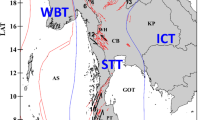Abstract
The IASPEI91 global travel-time curves are used as the default for event location at the Prototype International Data Center (PIDC). In order to improve event location, a 1-D Baltic travel-time model was implemented at the PIDC in 1997 for locating events using regional phases from Fennoscandian stations. Where a single model is insufficient for characterizing the regional geology, path-dependent corrections, or Source Specific Station Corrections (SSSCs), are more appropriate for event locations. We have developed SSSCs for regional phases at the Fennoscandian stations by interpolating travel times through different 1-D models. SSSCs for stations NRIS and SPITS are also derived, given the fact that paths from both stations to high latitude events are within the Fennoscandia regionalization as Baltic.
Validation testing of the SSSCs demonstrates that using SSSCs in event location is superior to not using SSSCs, and, in most cases, to using the 1-D model directly when locating events. For a ground-truth data set which includes events in the Baltic Shield with location accuracy better than 2 km, the average improvement in location due to SSSCs is 9 km, and the median coverage ellipse is reduced by 2710 km2(from 3830 to 1120 km2). These results are similar to those obtained using the 1-D Baltic model. For a CEB (Calibration Event Bulletin) data set which includes events along the North Atlantic oceanic ridge and in central/southern Europe, using SSSCs the ridge events move closer to the ridge axis, and the European events move closer to CEB locations than 1-D Baltic locations. For a constrained JHD (Joint Hypocenter Determination) data set of events in the Novaya Zemlya region, when using SSSCs or the 1-D Baltic model, relative to the JHD locations mislocations are less or similar to those without SSSCs. All coverage ellipses are smaller but still contain the JHD solutions.
Our SSSCs are strongly dependent on the 1-D regional models and regionalization. Future development in 1-D velocity models and travel-time curves should improve such SSSCs, event locations, and uncertainties. It is hoped that the implementation and demonstration of SSSCs in the PIDC software will encourage these further developments. These SSSCs were implemented at the PIDC for Reviewed Event Bulletin (REB) location in April 1999.
Access this chapter
Tax calculation will be finalised at checkout
Purchases are for personal use only
Preview
Unable to display preview. Download preview PDF.
Similar content being viewed by others
References
Bondar, I., and North, R. G. (1999), Development of Calibration Techniques for Potential Use by the CTBT International Monitoring System, Phys. Earth Planet. Int. 113, 11–24.
Bondar, I., North, R. G., and Beall, G. (1999), Teleseismic Slowness-azimuth Station Corrections for the International Monitoring System Seismic Network, Bull. Seismol. Soc. Am. 89, 989–1003.
Bondar, I., Yang, X., North, R. G., and Romney, C. (2001), Location Calibration Data for CTBTMonitoring at the Prototype International Data Center, this issue.
Bondár, I., Yang, X., Mclaughlin, K., North, R. G., Ryaboy, V., and Nagy, W. (1998), Source Specific Station Corrections for Regional Phases at IMS Stations in North America and Fennoscandia, Eos Trans. AGU, 79(45), Fall Meet. Suppl., F839.
Dewey, J. (1972), Seismicity and Tectonics of Western Venezuela, Bull. Seismol. Soc. Am. 62, 1711–1751. DOUGLAS, A. (1967), Joint Epicentre Determination, Nature 215, 47–48.
Israelsson, H., Fisk, M., Yang, X., and North, R. G. (1997), The August 16, 1997 Event in the Kara Sea, Center for Monitoring Research, Technical Report CMR-97/38.
Kennett B. L. N. (1991, ed.), Iaspei 1991 Seismological Tables, Research School of Earth Sciences. Australian National University, Canberra, Australia.
Kremenetskaya, E., and Asming, V. (1999), Location Calibration of the Barents Region, Proceedings of the Calibration Workshop, January 12–14, Oslo, Norway.
Mooney, W., Laske, G., and Masters, T. (1998), CRUST 5.1: A Global Crustal Model at 5X5, J. Geophys. Res. /03, 727–747.
Nagy, W. (1996), New Region-dependent Travel Time Handling Facilities at the IDC; Functionality, Testing and Implementation Details, Center for Monitoring Research, CCB-PRO-96/33.
Russian Federation/United States Calibration Working Group (1998), Evaluation of the IMS Location Accuracy of Large Chemical and Nuclear Explosions in Northern Eurasian and North America Using Regional and Global Pn Travel-time Tables, Proceedings of the 20th Annual Seismic Research Symposium on Monitoring CTBT, 104–113.
Stevens, J., and Mclaughlin, K. (1997), Improved Methods for Regionalized Surface Wave Analysis, Maxwell Technologies, MFD-TR-97–15887.
Yang, X., Mclaughlin, K., and North, R. G. (1999), Source Specific Station Corrections for Regional Phases at IMS Stations, Proceedings of the 21th Annual Seismic Research Symposium on Monitoring CTBT, 333–343.
Yang, X., and Mclaughlin, K. (1999), SSSCs for Regional Phases at Fennoscandian and Other Stations, Center for Monitoring Research, CCB-PRO-99/03.
Author information
Authors and Affiliations
Editor information
Editors and Affiliations
Rights and permissions
Copyright information
© 2001 Springer Basel AG
About this chapter
Cite this chapter
Yang, X., Bondár, I., McLaughlin, K., North, R. (2001). Source Specific Station Corrections for Regional Phases at Fennoscandian Stations. In: Ringdal, F., Kennett, B.L.N. (eds) Monitoring the Comprehensive Nuclear-Test-Ban Treaty: Sourse Location. Pageoph Topical Volumes. Birkhäuser, Basel. https://doi.org/10.1007/978-3-0348-8250-7_5
Download citation
DOI: https://doi.org/10.1007/978-3-0348-8250-7_5
Publisher Name: Birkhäuser, Basel
Print ISBN: 978-3-7643-6534-9
Online ISBN: 978-3-0348-8250-7
eBook Packages: Springer Book Archive




